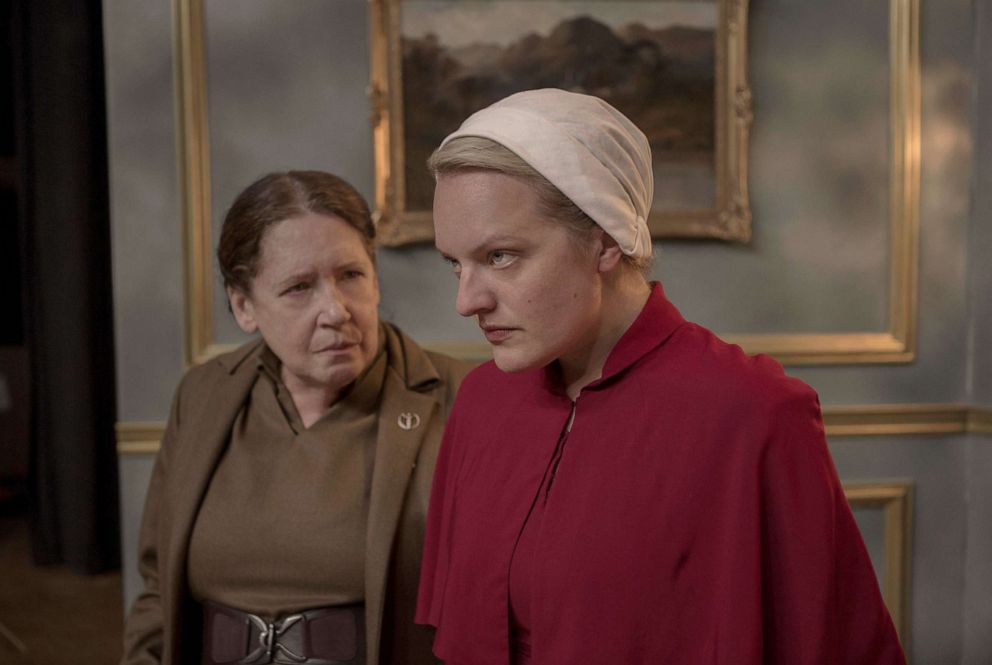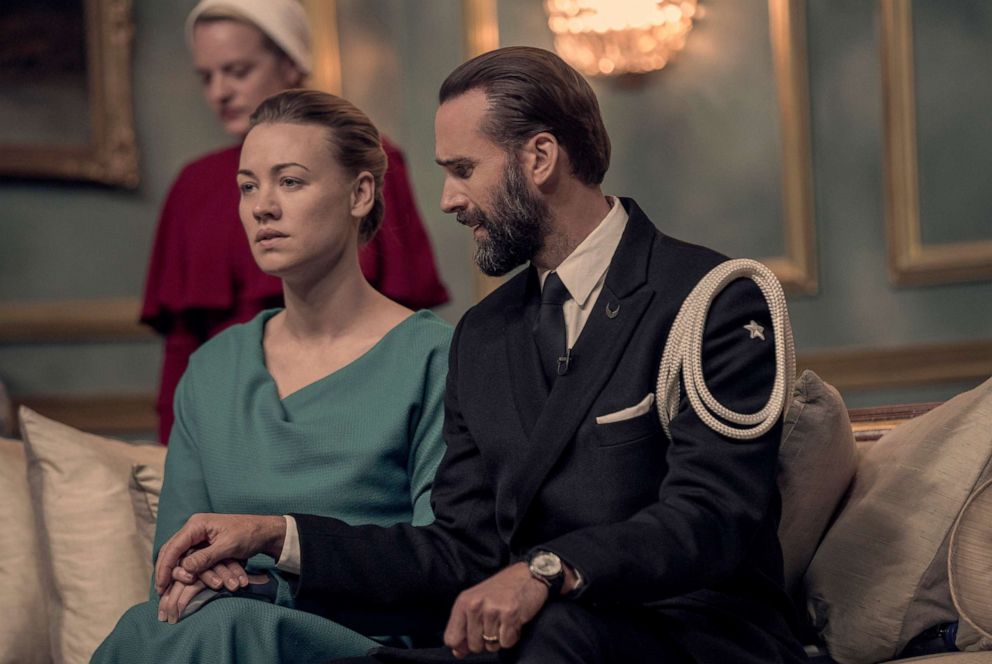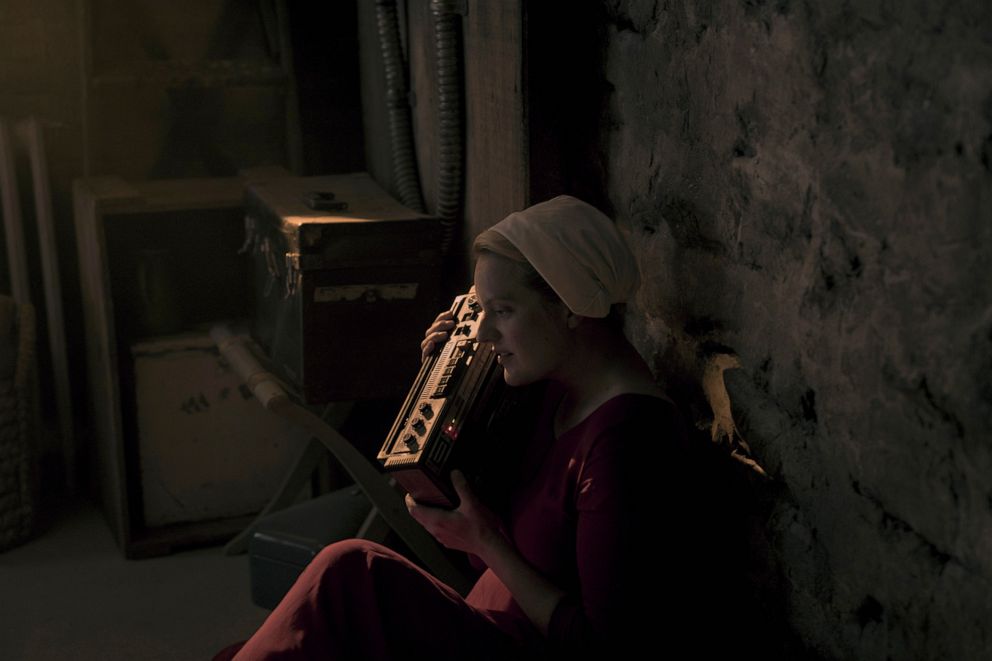'The Handmaid's Tale' creators and stars discuss the show becoming a symbol of resistance, struggle for women's rights
Creators and stars the show's influence on pop culture.
When Natalie Bronfman, the head costume designer for Hulu’s massive hit series “The Handmaid’s Tale,” created, along with former head costume designer Ane Crabtree, the blood red cloak worn by stars Elisabeth Moss, Samira Wiley and other handmaids characters, she said she “never had any idea” her design would become a cultural icon.
The cloaks have become a symbol of protest for global women’s rights – with crowds of women wearing them during protests for reproductive rights in Alabama and Georgia, equal pay and treatment protests in Hollywood, even in protests in London opposing President Trump's state visit.
The costume has catapulted the show’s themes of an oppressive alternative American regime into a real-life cultural phenomenon.
Moss is an executive producer on the show and plays lead character June.
“It's incredible,” Moss told “Nightline.” “I feel like those women that are wearing that costume or something like it and going and protesting … those are the really inspiring women. Those are the women who are actually doing the work. They're the women on the front lines who are out there risking something.”

“The Handmaid’s Tale" is set in a dystopian future where a right-wing fundamentalist religious group, Gilead, has overthrown most of the U.S. government, stripping women of almost all their rights.
In the show, fertile women are forced by rape to breed for barren couples among the ruling class.
The first season was based on author Margaret Atwood’s 1985 novel, “The Handmaid’s Tale,” which she said was written as a fictional warning.
“We’re not living in Gilead yet, but there are Gilead-like symptoms,” Atwood told “Nightline.”
Now in season three, the Hulu show has surpassed where Atwood’s first book left off. She released a “Handmaid’s Tale” sequel this year -- titled, “The Testaments” -- following the show's huge success and has served as a consulting producer on the show since the beginning.
Samira Wiley plays a handmaid who has escaped the regime and found asylum in Canada.
“One of the first things that comes to mind is exactly what's happening in our country, the conversation about women being able to make decisions about their own bodies-- which is exactly what's happening in the Handmaid's Tale,” Wiley said. “I'm also sometimes afraid to actually examine what the parallels are because -- I'm in a show that to me is fiction.”
Actor Bradley Whitford, who starred in TV’s politically resonant show, “The West Wing” for seven years, joined the “Handmaid’s” cast for season 2 as Commander Joseph Lawrence. He said he was “obsessed” with the show: “It was disorienting to kind of realize that there was a possibility of being on it.”
“We… feel there's a tremendous urgency to it,” Whitford said. “It’s a very important show… There is something going on in a lot of right wing ideology that has to do with misogyny, and has to do with controlling women. And that's only gotten more intense, very recently. And it's understandable that this... is hitting a nerve.”
The theme of season three, which premiered on June 5, is resistance.
“The thing that I think people relate to is that she's not a superhero. You know, she's a heroine-- but she's one of us,” Moss said. “She doesn't have any special powers… You know, she's a woman, she's a best friend, she's a wife, she's a mother, she's a human. And I think that… actually ends up inspiring people.”
“Nightline” was on set in Toronto, Canada, on the final day of filming of the third season. Production designer Elizabeth Williams, who has imagined and created every set for the show -- including Commander Lawrence’s home -- said that she tried to make her sets seem as close to real life as possible.
“If you stay as close as you can to reality and to what people recognize as being normal… and then you contrast that with you know, the story, which is dark. It's that contrast,” Williams said. “It's that juxtaposition of the good and the bad… which is jarring I think for people. It makes us feel uncomfortable.”
For example, in Commander Lawrence’s home, Williams said she features real herbs and food in the kitchen.
“We pick and choose from real life,” Williams said. “Just like actually Margaret Atwood does in her book -- she says, you know, nothing that I've written hasn't already happened. And nothing that we build doesn't already exist.”
The person responsible for the show’s addictive plot line is show creator and executive producer Bruce Miller.
“It's scary when you show up on set. You typed something in your living room and, you know, say exterior, you know, Central Station at night. And then all of a sudden, there's all this stuff,” Miller said. “You know, and you just kind of have imagined it into reality.”
His imagination has earned the show 11 Emmys, including one for best writing.
“I don't write a super lot of dialogue, especially since in this show, in this world, they don't speak very much. And they're very careful about what they say,” Miller said. “That's how you make it good 'cause it's not what you write, it's what the people do with it… Almost all the time I'm stripping out things that the actors can do better with their faces or with their bodies than… the words.”
Another major plot line of this season is the continued plight of Commander Fred Waterford and his wife Serena, played by Joseph Fiennes and Yvonne Strahovski. Amanda Brugel plays Rita, a “Martha” and the Waterford’s loyal housekeeper.

“I'm not given a lot of lines to communicate,” she told “Nightline.” “I started slowly learning how to steal moments, even if they weren't written in the script. In season two, I take a swig of champagne or I'm constantly, like, touching characters when I shouldn't be, or just adding other things in to sort of give more dimension to a performance.”
Particular to the show’s style is June’s first person narration.
“The voiceover's such a fluid thing, because if I'm doing a scene where I'm doing the voiceover, I will have the voiceover where it's in my head and act to that,” Moss shared. “Sometimes what ends up happening then is in the cut you don't need the voiceover, because it's come out in the performance, in the visuals… we always try to make sure that it is something that adds to the story or illuminates, and not something that explains. It can't be something that we're using as a cheat.”
Her continuous, colorful language is an unusually effective tool in nailing her character's emotions - and probably yours, too. Moss says she’s actually the one who will decide to sometimes not drop “f-bombs.”
“Sometimes it can be too much, or it can be, like, something that you lean on or use as a crutch. So I try to actually make sure that they're really specifically used,” Moss said. “Sometimes you lose something in swearing, actually. You lose a power, sometimes. But sometimes it adds a little something.”

Ann Dowd plays Aunt Lydia, a terrifying player in the patriarchy. But when it comes to real life, Dowd is anything but.
“When I see women having the strength to get those costumes on and go out in the street it practically makes me weep,” Dowd told “Nightline.” “It makes me wanna get on my hands and knees in gratitude for the strength and the persistence, and to stand up and say, ‘No.’ To think that something that is on a television can transfer into a significant protest, I mean, the great fortune of being part of that, I think it's extraordinary, really do.”
That feeling is shared by many on set, including Max Minghella, who plays Nick Blaine, a mysterious “Eye” and June’s secret former lover.
“I think we're incredibly proud of how it's resonated, how it hopefully has inspired,” Minghella told ABC News. “I think that it's very much on the right side of this conversation.”




